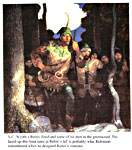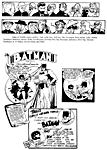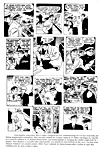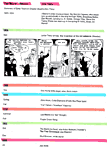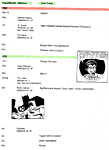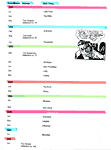|
How Much Did Batman Knock-off Dick
Tracy?
Were the Picturesque Batcrooks Inspired by Chester Gould’s Gallery of Grotesques?
Mysteries
swirl around the Darknight Detective. Some of the questions went unanswered to the grave with Bill Finger in
1974; others, with Bob Kane in 1998. And now only Jerry Robinson is left of the
crew that ginned up the early Batman stories. But not even Robinson can lay all the mysteries to rest. One of the
mysteries, however, I hope to resolve herewith. The Chester Gould
connection—true or not?
The
Comics Buyer’s Guide’s issue on Batman (no. 1328, dated April 30, 1999)
included an interview with Jerry Robinson, who, in assisting Bob Kane with art
chores on the early Batman stuff, was involved in the creation of both Robin
the Boy Wonder and the Joker, a key Batman villain. The question of who created
whom, or what, has hung over these characters for a generation. Kane says he
created the Joker; Robinson says he did. Kane says he created Robin; Robinson
admits he didn’t create the Boy Wonder but says he named the character and
devised his costume. And he says the same thing in the first part of the recent
two-part interview in The Comics Journal (no.
271 in October 2005). Bill Finger, the writer who should have been given at
least as much credit for Batman as Kane, isn’t around and hasn’t been around,
so there’s no other witness we can consult. It’s one man’s word against
another’s without letup. Or one man’s recollection against another’s. And memory
is forever fallible. Still, considering Kane’s larger-than-life ego, I’m
tempted to discount his claim as being just so much more hot air. But that is
entirely beside the point at hand.
At hand is something else
altogether. Related, perhaps, but wholly different. The question is: To what
extent were both Robin and the Joker inspired by Chester Gould’s Dick Tracy? Were Kane and company
more-or-less under the spell of Gould’s strip? The Joker and Two-face and the
Penguin and the Riddler—all smack of Gould grotesques like Pruneface and
Flattop and the like. Most witnesses nod in agreement on this matter:
Obviously, Kane and his cohorts were imitating Gould. And Kane himself (in Batman and Me, p. 105) seems to agree.
He says Dick Tracy “inspired us to
create an equally weird set of villains for Batman.”
Maybe, maybe not. In any case,
prompted by a desire to Find the Truth So Help Me, I decided to examine the
Gould connection a little more closely.
Robin, I always thought, was Junior
Tracy in tights. And Jay Maeder agrees. In his book on the Gould oeuvre called Dick Tracy: The Official Biography (Penguin Books, 1990), Maeder says: “Kane usually acknowledged that he had
lifted the premise straight from Dick
Tracy” (p. 22). What’s more, Maeder says “Gould invented the comic
tradition of the Boy Sidekick” with Junior Tracy, who arrived on September 8,
1932. Robin didn’t show up until years later—in Detective Comics no. 38, cover-dated April 1940. Yes, the first of
these two kid sidekicks was clearly Junior. But it’s not certain that Junior
directly inspired Robin.
In CBG, Robinson says Robin was conjured up in order to give Batman
somebody to talk to. It’s an old dilemma in comics, and the solution was fairly
threadbare by even 1940. Give the protagonist a sidekick. Spud, Hotshot
Charlie, Happy Easter, and so on. “I’m sure it was Bill’s idea for adding a
boy,” Robinson told Gary Groth in The
Comics Journal (no. 171, p. 82). “That I would attribute to Bill without
question. When I came in they were already discussing possible names. So I
joined the discussion of the creation. There was nothing on paper yet, nothing
but the idea of adding a sidekick. And I know that was Bill’s idea to add a
sidekick from the discussion that ensued. The impetus came from Bill’s wanting
to extend the parameters of the story potential and of the drama. He saw that
adding a sidekick would enhance the drama. Also, it enlarged the readership
identification. The younger kids could then identify with Robin, which they
couldn’t with Batman, and the older ones with Batman. It extended the appeal on
a lot of levels.”
At first, Robinson says, Kane and
Finger were going to call the new kid Mercury or some such moniker from a long
list they had of mythological characters, but Robinson offered “Robin” based
upon his affection for Robin Hood. “I had been given a Robin Hood book
illustrated by N.C. Wyeth,” he said, “—full-plate tip-in [illustrations]. I
remembered those because I had pored over them so many times as a kid. I had a
vision of Robin Hood just as Wyeth drew him in his costume, and that’s what I
quickly sketched out when I suggested [the name] Robin, which they seemed to
like, and then showed them the costume. And if you look at it, it’s Wyeth’s
costume, from my memory, because I didn’t have the book to look at. But it is
pretty accurate: the fake mail pants, the red vest, upon which I added the
little ‘R’ to correspond with Batman’s bat on his chest.” With that, the deal was done.
Robin—named and costumed. No mention of Junior Tracy, though, even if Junior
was the first kid sidekick in popular literature.
Grotesque villains are another
somewhat more complicated matter. Dick
Tracy is famous for them. So is Batman. Again, which came first seems decisive. Tracy is older by almost a decade; clearly, Gould’s grotesques, because they were
first, inspired Kane.
It’s always assumed that any
copycatting had to be on the comic book side: newspaper cartoonists in those
days didn’t stoop to reading comic books. And comic book creators, most of whom
aspired to greater things, like syndication with a comic strip of their own,
looked to newspaper comic strips for two kinds of inspiration: strip
cartoonists were living proof that fame and fortune awaited if you could get
yourself syndicated, and the material they trafficked in seemed somehow better
and therefore more imitatable than comic book material. So obviously, the usual
assumption runs, Kane and company borrowed from Gould. Well, maybe, maybe not.
Tracy achieved early fame for its realistic depiction of criminal brutality. Lots of
bloodshed and sadistic cruelty. And lots of references in the strip to real
crooks in the news. Gould tucked Al Capone and John Dillinger into the strip as
Big Boy and Boris Arson. Arson escapes from prison by using a
Dillinger-inspired dodge: carving a pistol out of a potato and then dying it
black with iodine. But he doesn’t look anything like Dillinger. Then came
Stooge Viller, who looked like Edward G. Robinson in one of the decade’s
numerous Hollywood gangster flicks. And then along came wicked Steve the Tramp,
who later reformed. Others included Doc Hump, Larceny Lu, Stud Bronzen, Jojo
Niddle, Scardol, and Professor Emirc. Unsavory types, no question. But not
grotesques. And the point of comparison between Batman and Dick Tracy is
with grotesques—characters who look like their names, or whose names suggest
their personalities. The Joker, the Penguin, Pruneface, Clay Face, Two-face,
Flattop, Shoulders, the Riddler, Itchy, B-B Eyes, etc. When did the first of
those show up? That’s easy to discern with Batman,
who debuted in a May 1939 issue of Detective
Comics (no. 27). The first grotesque in the Batman canon is the Joker, who
shows up in the inaugural issue of Batman
Comics in the spring of 1940; and then comes Clay Face, who appears in Detective Comics no. 40, cover-dated
June 1940. Both are grotesques. When did comparable (or copyable) characters
show up in Dick Tracy? Surprisingly,
not in time to inspire the Joker.
Grotesques were not a distinctive
feature of the strip until the 1940s.
(See the Timeline charts at the end.) That’s when Flattop and Pruneface and the
like came along. Still, the strip was on the scene long before the Batman comic
books. Was there anything in it before the Joker’s debut that Kane and/or
Robinson might have been imitating?
Probably the earliest grotesque in Tracy was Doc Hump who was operating
fiendishly on his canine cohorts in late 1934. Next was “the Blank,” whose name
was Ankle Redrum (“murder” spelled backwards); he wore a cheesecloth mask that
acted to blur his facial features, which had been horribly disfigured in an
accident of some sort. He bowed onto Tracy’s stage in October 1937. Both
earlier than the Joker. But probably too early to inspire the Joker. Professor
Emirc (“crime” spelled backwards) in Tracy was an ugly cuss and might be considered another precursor to the
grotesques of the forties; he arrived in the fall of 1939, early enough to
coincide, perhaps, with the creation of the Joker—or, at least, to be a fresh
memory when Kane or Robinson started looking for a memorable antagonist for
Batman. They were looking for someone like Emirc or Stooge Viller (who had
returned in October 1939 to plague Tracy again). Or Big Boy, Gould’s stand-in
for Al Capone. Big Boy came back a couple times to haunt Tracy, and Kane and
company were looking for someone like that. A worthy opponent. Someone who
would come back again and again.
Batman’s first “name” villain had
been Dr. Death, who showed up for Batman’s third adventure (July 1939). He
might have been inspired by Gould’s Doc Hump, but that’s hard to say without
actual testimony: by July 1939, Doc Hump was almost five years in Tracy’s past.
He might have been too far back to be even a distant memory in Kane’s mind or
Robinson’s. Besides, by 1939, they had other models.
What Kane and company came up with
as a memorable opponent for Batman was the Joker. How they came up with it
depends upon whose story you like best.
Robinson’s
Story. With Batman coming into his own at the end of 1939 and about to star
in his own book (which would be released with a spring 1940 cover-date) as well
as in Detective Comics, they needed
more Darknight Detective stories. Bill Finger was a slow worker, Robinson
remembers, and obviously couldn’t produce enough stories to sustain both Detective and Batman comic books, so Robinson, who had aspired to be a writer
when in high school and was now attending Columbia U. and taking writing
courses, volunteered to try a story, probably in early 1940. One night, he
says, he went home in great excitement to come up with something. According to
Robinson in CBG, what he was seeking,
the thing that prompted his creation of the Joker, was the need for “a more
important adversary” for Batman. “Many of the great heroes of literature had
protagonists to pit their strengths and brains against ... formidable
adversaries. ... I wanted a memorable character with some contradiction in his
nature—a contradiction in terms.”
The Joker’s name, oddly, came first
as Robinson recalls: “The stories I liked best that I wrote for the highschool
paper had twist endings and humor. My affinity for humor led me to a villain
with a sense of humor. An interesting combination. [And containing a
contradiction in terms—a crook with a sense of humor.—RCH] Then I needed a
unique name for the villain. The Joker must have come from my association with
cards, which I loved to play. It was about 1 a.m. when I began searching for a
deck of cards. I eventually found one and fortunately it had the classic clown
Joker image. That was just the kind of image I was looking for: the perfect
visage for the Joker. And it combined the concept of the character—a villain
with a touch of humor.”
He based the visualization of the
Joker on the image on the playing card, retaining the chalk-white complexion.
When he presented his idea to Kane and Finger, they liked it so much that Kane
persuaded Robinson to let Finger, the star writer of the team, write the origin
story that Robinson had initially volunteered to do. “Bill was an experienced
writer,” Robinson said, “and it was a sensible decision to have him write the
story.”
Nothing in this about Chester Gould.
Robinson had to have been reading Dick
Tracy: at the time, it was a popular strip and ran on the front page of the
Sunday comics in The New York Daily News. Robinson couldn’t have avoided the strip—even if he’d wanted to. But, as we’ve
seen, Dick Tracy at the time didn’t
number any conspicuous grotesques like the Joker in the cast. So whether
Robinson was reading Dick Tracy or
not doesn’t matter.
That’s Robinson’s version.
Kane’s
story, which he said is supported by E. Nelson Bridwell’s report of Finger’s
recollection, begins with Kane wanting to create a worthy antagonist for
Batman. Kane came up with the Joker playing card and the concept of a
joke-playing villain. He says he showed his sketches based upon the playing
card to Finger, who “liked the idea of a compulsive practical joker, and we
kicked around ideas about a maniacal killer who would play life-and-death jokes
on Batman, and that would test his mettle and ability to outwit his foe.” About
a week later, Kane says, Finger came into the studio with a photograph of
Conrad Veidt, an actor, made up for his role in a movie called “The Man Who
Laughs.” Finger thought Veidt’s visage was a better image for the Joker than
the clownish creation that had come from Kane’s pen, and Kane agreed.
Robinson’s playing card Joker came in after this, Kane maintains—Robinson’s
contribution was to put Veidt’s face on the Joker playing card as a calling
card for their new villain. But this took place after the Joker was invented,
Kane says.
Robinson’s version of the Joker’s
creation can be incorporated into Kane’s—albeit with a shoe-horn. When Robinson
volunteered to write the story, Kane may not have taken the youth’s intentions
seriously, and so he forgot that Robinson was on the assignment. Meanwhile, he
and Finger went ahead with their discussion of what might be a “memorable”
villain. He may have also forgotten that Robinson brought the Joker to them.
What he remembered was Finger bringing in the Veidt photograph, which Finger
could well have done after Robinson came up with the
character and the playing card image—as a way of affirming the rightness of the
concept by way of contributing to the visualization of the character. And Kane
remembered using Veidt’s visage on a playing card. Maybe it fits. But an internal
contradiction betrays Kane: he says he conjured up with the notion of the Joker
playing card; and then he says Robinson’s playing card came after the Veidt
inspiration. By offering contradictory theories, Kane reveals that one of them
is made up. Which one?
Maybe it doesn’t matter. We can’t
escape the fundamental fact that both Kane and Robinson claim to have invented
the joke-playing villain and the playing card image. Clearly, both could not
have done it. And considering Kane’s cavalier treatment of Finger, I’d opt
every time not to believe anything Kane said when the utterance tended to
elevate his reputation above that of his collaborators. Self-aggrandizement was
Kane’s forte, not creative imagination.
Fine. But Chester Gould doesn’t
figure in Kane’s version either. No surprise: as I said, the Gould gallery of
grotesques was yet to come. His work was probably not at all inspirational for
the Batman team at this moment—for the creation of the Joker, that is—or, for
that matter, for Clay Face, who shows up that June. The Blank might have
inspired this character, but the Blank, by this time, was over two years in the
past. Another perhaps too distant character for anything but subliminal
inspiration. And that, of course, could have happened. But speculation about
conscious thought-processes is hazardous enough without my wandering into the
caverns of the subconscious. It seems clear that neither the Joker nor Clay
Face could have been inspired by Gould’s grotesques. Later maybe—for the
Penguin and Two-face and maybe the Riddler and a few others I suppose—maybe
then Kane and company took a leaf from Gould’s 1940s scrapbook. But not for the
Joker: his creation was simply too early.
The Penguin may have been inspired
by Gould. The Penguin was the next grotesque villain in the Batman tales after
Clay Face, and the Penguin shows up in Detective no. 58, cover-dated December 1941. By then, Gould had started introducing the
kinds of crooks that he would soon become celebrated for. Deafy Sweetfellow, a
criminal who is hard of hearing, showed up in October 1940, a year before the
Penguin. And Little Face came along in July 1941; the Mole, in November 1941.
The latter would be too late to inflame the imaginations of the Batman team:
for the Penguin’s debut in a December-dated comic book—which doubtless hit the
newsstands in early November—Kane’s crew would probably have been scripting in
August or September. At that time, they would have seen Little Face and Deafy,
but not the Mole.
So what do we have here? Well, even though
the concept of Gould’s grotesques as criminals echoes in Kane’s roster of
rogues, the latter probably was not as frequently inspired by the former as
Kane remembered. It’s uncharacteristically gracious of Kane to nod in Gould’s
direction. Maybe Kane was, in a backhanded and perhaps nearly subconscious way,
thanking Gould for Batman’s jaw, which had become squarer and squarer as the
months rolled on. Batman’s profile surely evoked Tracy’s eventually, but not in
the early years. In those years, Batman’s profile wasn’t all that razor-edged.
The foregoing is a revised and up-dated
version of an essay that appeared in The
Comics Journal in 1999. For more about Chester Gould and the
invention of Dick Tracy, click here to be transported to another Hindsight file.
|
|||||
